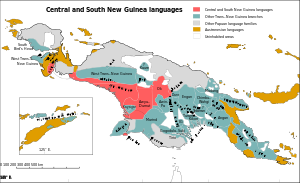| Central and South New Guinea | |
|---|---|
| Asmat–Ok | |
| Geographic distribution | New Guinea |
| Linguistic classification | Trans–New Guinea
|
| Subdivisions | |
| Glottolog | cent2116 |
 Map: The Central and South New Guinea languages of New Guinea
The Central and South New Guinea languages
Other Trans–New Guinea languages
Other Papuan languages
Austronesian languages
Uninhabited | |
The Central and South New Guinea languages (CSNG) are a proposed family of Trans–New Guinea languages (TNG). They were part of Voorhoeve & McElhanon's original TNG proposal, but have been reduced in scope by half (nine families to four) in the classification of Malcolm Ross. According to Ross, it is not clear if the pronoun similarities between the four remaining branches of Central and South New Guinea are retentions for proto-TNG forms or shared innovations defining a single branch of TNG. Voorhoeve argues independently for an Awyu–Ok relationship, and Foley echoes that Asmat may be closest to Awyu and Ok of the TNG languages. Regardless, the four individual branches of reduced Central and South New Guinea are themselves clearly valid families.
- Central and South New Guinea (Asmat–Ok)
- Asmat–Kamoro family [a recent expansion along the south coast]
- Greater Awyu family
- Mombum family
- Ok–Oksapmin family
Ethnologue (2009) retains only Awyu–Dumut and Ok, calling the branch Ok–Awyu, and places Asmat and Mombum as independent branches of TNG. Loughnane & Fedden (2011) link Ok to the Oksapmin language.[1] However, van den Heuvel & Fedden (2014) argue that Greater Awyu and Greater Ok are not genetically related, but that their similarities are due to intensive contact.[2]
The Somahai languages and Bayono-Awbono may also belong here, but there is little data to go on.
YouTube Encyclopedic
-
1/5Views:106 9681 225 154135 4696 525586 999
-
New Guinea - lessons from a cradle of agriculture and languages
-
Geography Now! PAPUA NEW GUINEA
-
Who Exactly is an Australoid/Veddoid?
-
ENGLISH & TOK PISIN
-
The Languages of Africa
Transcription
History
In the mid 1960s, Alan Healey, a colleague of Laycock, noted connections between the Ok, Asmat, and Awyu–Dumut families. Voorhoeve (1968) expanded on this and coined the name CSNG; his proposal added Trans-Fly and Marind to the mix. Collaboration with McElhanon and his Finisterre–Huon family in 1970 found a connection between them, which was named Trans–New Guinea. Wurm's 1975 expansion of TNG also expanded CSNG, with the addition of Awin–Pa, Bosavi, Duna–Pogaya, East Strickland, Mombum, and Momuna. Ross's recension in 2005 retained nothing from Voorhoeve and only Mombum from Wurm, though the Momuna languages were too sparsely attested for him to classify.
See also
References
- ^ Loughnane, Robyn and Fedden, Sebastian (2011) 'Is Oksapmin Ok?-A Study of the Genetic Relationship between Oksapmin and the Ok Languages', Australian Journal of Linguistics, 31: 1, 1-42.
- ^ van den Heuvel, W. & Fedden, S. (2014). Greater Awyu and Greater Ok: Inheritance or Contact? Oceanic Linguistics 53(1), 1-36. University of Hawai'i Press.
- Ross, Malcolm (2005). "Pronouns as a preliminary diagnostic for grouping Papuan languages". In Andrew Pawley; Robert Attenborough; Robin Hide; Jack Golson (eds.). Papuan pasts: cultural, linguistic and biological histories of Papuan-speaking peoples. Canberra: Pacific Linguistics. pp. 15–66. ISBN 0858835622. OCLC 67292782.
